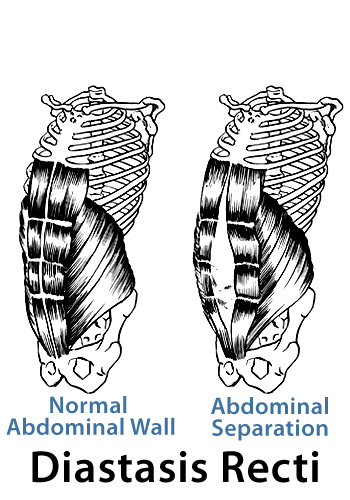 During pregnancy, your abdominal muscles become stretched out because of the fetus’s increasing size. They lose some of the force they were able to generate prior to pregnancy. Think of a rubber band that has been stretched for a while and then released. It doesn’t just snap back on its own.
During pregnancy, your abdominal muscles become stretched out because of the fetus’s increasing size. They lose some of the force they were able to generate prior to pregnancy. Think of a rubber band that has been stretched for a while and then released. It doesn’t just snap back on its own.
Diastasis Recti (or Split Abdominal Muscles) is a very common, perfectly normal & painless parting of these muscles. Up to two thirds of women will have developed it during their pregnancies.
The function of this muscle is to support your back & your organs. So when the muscles separate, this support system is weakened causing low back pain & a Mummy Tummy. Your organs actually protrude as they are being supported only by a thin piece of connective tissue.
What causes Diastasis Recti Abdominis (DRA) ?
1. Pregnancy, 2. large babies 3. obesity 4. weak abdominals prior to pregnancy. 5. Women who have had multiple pregnancies may experience this condition as a result of previously stretched abdomen muscles.
Fixing Diastasis Recti will not only get rid of the horrible “mommy tummy”, it also helps reduce back pain as the abdominal muscles help support the spine and internal organs.
The goal of Neuromuscular Therapy (NMT) is to address posture, muscular dysfunction and pelvic floor facilitation to resolve pelvic and/or low back pain.
Learn how an effective treatment plan applying integrative proven techniques will improve you health. Want to know what your first appointment will be like?
Diastasis Rectus Abdominis and Lumbo-Pelvic Pain and Dysfunction-Are They Related?
This condition can have significant repercussion to the locomotors system in causing a great degree of pain and discomfort throughout the entire body. Low tone of abdominal musculature is the sole cause of Diastasis Recti in post partum women. Most commonly it is the outcome of the overall lack of balance between all muscles with abdomen as well as the diaphragm and the muscles of the pelvic floor.
DRA hinders the function of the abdominal wall and its contribution to posture, trunk stability, respiration, visceral support, pelvic floor facilitation. It is thought that a DRA contributes to chronic pelvic and low back pain, as well as bowel and bladder dysfunction.
Poor Posture
People who have diastasis recti may experience poor posture due to weakened abdominal muscles, according to the website Pregnancy-Info-net. Pregnant women with this condition may experience poor posture as their abdominal muscles stretch to accommodate the growing baby. During late pregnancy, abdominal muscles lose some of their ability to contract and keep the body aligned, which can result in poor posture, according to California’s Sutter Health Hospital. Pregnant women may notice a change in posture during the second and third trimester as their muscles become overly stretched and separate.

